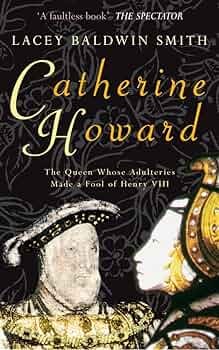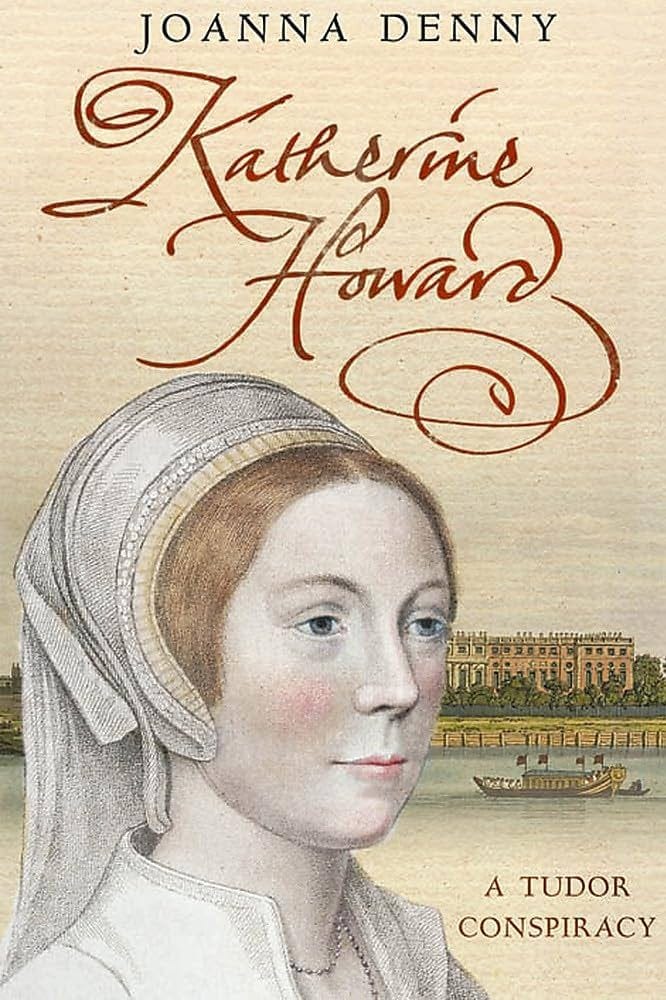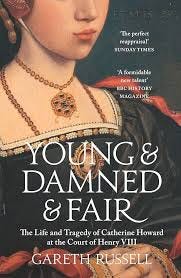Juvenile Delinquent to Innocent Victim - The Biographies of Kathryn Howard
The top six biographies of Kathryn Howard ranked in ascending order.
After recently completing my dissertation on Kathryn Howard’s representations in popular culture, it seems remiss that I have yet to write a post about her. She’s been such a big part of my life for so many months now, and I’ve enjoyed delving into her story and her legacy in great depth.
I’ve been incredibly lucky to share my research with so many of you, either via my Instagram page or in podcast interviews. Often I have discussed Kathryn’s appearance on film, stage and TV, yet her portrayals within popular history books also formed a major element of my investigation into how Kathryn has been perceived over time.
The debate surrounding the true nature of Kathryn’s relationships with Henry Manox, Francis Dereham and Thomas Culpepper, has sparked questions, theories and divisions amongst historians for generations. They have also attempted on numerous occasions to grasp the ‘real’ Kathryn within the little surviving source material, which has triggered a variety of differing and contrary conclusions.
Of course, Kathryn Howard has featured in many books concerning the Tudor queens, including Alison Weir’s ‘The Six Wives of Henry VIII’ and Agnes Strickland’s collective biography of England’s queen consorts. Yet there have only been a handful of biographies which focus solely on Henry VIII’s fifth wife. This shouldn’t come as a surprise, considering that there are few surviving sources surrounding Kathryn Howard and her brief tenure as queen. It’s difficult to create an accurate and comprehensive study of a character when there’s so little to play with.
Yet a few historians have dedicated books to Kathryn Howard’s life, all of which were invaluable to my research for various reasons, both good and bad. So I’ve ranked the Kathryn biographies below, in the hope of encouraging you all to pick up a copy and discover more about this remarkable queen.
6. ’Catherine Howard: The Adulterous Wife of Henry VIII’ by David Loades
‘She [Kathryn] simply lacked the intellectual and moral resources for such a position.’
This quote just says it all really! Written in 2012, this biography followed in the wake of more sympathetic narratives headed by Retha Warnicke and Joanna Denny. Yet Loades completely disregarded these new theories, and further cemented the negative stereotypes which have plagued Kathryn’s personality and sexuality for centuries.
For example, Loades referred to Queen Kathryn as ‘proud and careless’ and called her a ‘pampered and irresponsible child’, who ‘lacked the intellectual and moral resources’ required for queenship. He also openly admitted that Kathryn’s life was dominated by sex, so therefore ‘a biography is inevitably largely a study of her sexuality and its consequences’. Nothing about her reign, education, or relationships with other women then?
As well as damning her character, Loades blamed Kathryn entirely for her supposedly reckless sexual history which ultimately caused her downfall. Describing her relationships with Francis Dereham and Thomas Culpepper as ‘sheer folly’, Loades goes on accuse Kathryn of committing adultery simply because she was sexually frustrated and romantically deprived during her marriage to Henry. No mention is made towards Kathryn’s allegations of rape against Dereham, (in fact, their entire relationship is squeezed into two measly paragraphs!), and her interactions with Culpepper are reduced to a thoughtless dalliance on Kathryn’s part. Even if Loades didn’t agree with the more sympathetic interpretations suggested by Warnicke and Denny, the fact that he never even considered them makes this biography appear purely misogynistic and a lazy rehash of the traditional narrative.
5. ‘A Tudor Tragedy: The Life and Times of Catherine Howard’ by Lacey Baldwin Smith
‘Here in a twisted, obscure sort of way lies the essential failure of Catherine Howard’s life: although she was caught up in the game of politics and was never a free agent, the Queen never brought happiness or love, security or respect, into the world in which she lived. She enacted a light-hearted dream in which juvenile delinquency, wanton selfishness and ephemeral hedonism were the abiding themes. Who is to say whose fault it was - Catherine’s or that of her age?’.
In 1961, Lacey Baldwin Smith wrote the first biography dedicated to Kathryn Howard and as you can see, it’s hugely contradictory. First Smith would highlight the vulnerabilities surrounding Kathryn’s age, social status and upbringing, before descending into a rant about her supposed inadequacies. He frequently referred to Kathryn’s ‘silly little head’ and applied other derogatory terms also, including ‘juvenile delinquent’.
Smith certainly didn’t hold back from highlighting Kathryn’s flaws. ‘A Tudor Tragedy’ is immensely critical of Kathryn’s romantic liaisons, and placed the blame for her eventual execution firmly on her shoulders. To Smith, Kathryn held ‘few inhibitions’; could be ‘cruel’ to the men around her; was ‘pretty and giddy, unscrupulous and passionate’, and highly incapable of being a good queen. Here is a Kathryn who fell too easily to flattery and never thought of the long-term consequences of her actions. In other words, Kathryn Howard was a silly little girl who deserved what was coming to her.
The reason why I didn’t place ‘A Tudor Tragedy’ at the bottom on my list, is because Smith certainly was a historian of his time. It certainly does not excuse his heavy-handed criticisms, yet Smith was writing on the eve of second-wave feminism, which witnessed the call to end the objectification of women and the negative stigmas surrounding female sexuality. I highly doubt 1960s feminism would have changed Smith’s conclusions surrounding Kathryn’s life and character, yet the timing of the book’s publication has to be considered. Arguably a book of its time, thus Lacey Baldwin Smith’s ‘A Tudor Tragedy’ is not at the bottom on the pile, and still continues to shed light on how Kathryn has been perceived in a world before greater gender equality.
4. ‘Katherine Howard: A Tudor Conspiracy’ by Joanna Denny
‘Katherine has been described by some writers as “a juvenile delinquent’, but even now she was not yet 14 years old. A correct reading of her age is crucial to the perception and understanding of the young girl caught in the maelstrom of ambition and intrigue.’
Writing in 2005, Joanna Denny composed one of the first sympathetic representations of Kathryn Howard. To Denny, Kathryn’s age was a huge factor in determining the true nature of her sexual relationships with Manox and Dereham. Believing that Kathryn was born in 1525, Denny proposed that Kathryn was merely 11 years old when Manox took advantage of her. This technically made Kathryn a victim of child abuse, rather than a promiscuous tart as traditionally thought. Kathryn’s youth underlined the entirety of Denny’s argument that Kathryn was in fact a young girl, who was targeted by ambitious and violent men. Similar to Warnicke’s view of Kathryn, Denny set the ball rolling in reconsidering Kathryn’s reputation in a better light.
However, I have to say that Denny’s findings fall short when discussing Kathryn’s relationship with Culpepper. I personally do not believe that Kathryn was compelled to sleep with Culpepper by her family, in the hopes of birthing an illegitimate heir to the throne. Nor was Kathryn’s accusations that Dereham raped her ever considered in this biography. So while Joanna Denny’s work is heralded as a watershed moment in portrayals of Kathryn Howard, this biography still falls short in proposing a fully convincing representation of this maligned queen.
3. ‘Katherine Howard: Henry VIII’s Slandered Queen’ by Conor Byrne
‘Unfortunately, the frequent references to Katherine in modern historical accounts as a ‘tart’ or ‘whore’, coupled with the titillating portrayals of her in film and television productions such as The Tudors, have encouraged the dominant perception of her as an adulteress, but the lack of extant evidence to support this interpretation of her character is another example of how she has been slandered since her execution.’
Conor Byrne’s biography on Kathryn Howard is one of my favourites! Interpreting Kathryn’s experiences in the context of 16th century social customs and cultural values, Byrne looks at Kathryn’s story through a gendered lens to argue that contemporary mistrust of female sexuality had damaged the Queens’ reputation for centuries. Thankfully, works such as Byrne’s have started to undermine her negative legacy.
Fighting against the misogynistic perspective surrounding Kathryn’s sexual relationships, Byrne proposed that Kathryn was ‘coerced’ by Manox; psychologically abused by Dereham, and manipulated by Culpepper into meeting him against her will. This biography placed the blame for Kathryn’s downfall entirely upon the men’s shoulders. By reevaluating the evidence and reading between the lines, Byrne offered a very persuasive revision of Kathryn Howard’s story, and highlighted how 16th century misogyny continued to plague Kathryn’s reputation until the present day. Even if readers didn’t agree with Byrne’s conclusions, it was still a refreshing analysis.
I also loved Byrne’s discussion on popular portrayals of Kathryn Howard, which proved to be invaluable for my research, as well as a unique (and arguably vital!) addition to any Kathryn Howard biography.
2. ‘Katherine Howard: The Tragic Story of Henry VIII’s Fifth Queen’ by Josephine Wilkinson
‘[Kathryn] simply had to endure, and, as is so often the case with those who are mistreated and exploited, she accepted that Dereham’s behaviour towards her, though unwelcome, was in some way normal.’
Josephine Wilkinson’s insights into Kathryn Howard’s story largely mirrored Byrne’s, in the sense that she also applied 16th century social and gender norms in order to reinterpret the evidence surrounding Kathryn’s pre- and post-marital relationships. However, like Byrne, Wilkinson certainly used our modern understanding surrounding abuse and the consequences of sexual harassment when researching Kathryn’s experiences.
For instance, Wilkinson argued that Kathryn’s relatively lowly position before her marriage, made Kathryn vulnerable to Dereham’s unwanted advances. Moreover, because Kathryn was merely a woman, Wilkinson believed that she still would have felt unable to speak out about what she endured at Manox and Dereham’s hands, because patriarchal societies still placed a woman’s word below that of a man’s, regardless of their social station. This book also considered Culpepper’s possibly violent history when studying his intentions towards the queen. What’s more, like Byrne, Wilkinson also acknowledged Kathryn’s claims that Dereham raped her and tried to promote the truth behind those claims within the context of 16th century social norms.
Ultimately, Josephine Wilkinson’s biography on Kathryn Howard is one of best out there. It succeeds in making Kathryn’s story relevant to modern readers, and revises her story in a compelling and persuasive way. It was incredibly difficult to differentiate between Byrne and Wilkinson’s biographies, as they’re both relatively equal in my eyes. Yet I placed Wilkinson in second place, merely because I know of many others who have read Wilkinson’s work and were utterly enthralled with it.
1. ‘Young & Damned & Fair: The Life and Tragedy of Catherine Howard at the Court of Henry VIII’ by Gareth Russell
‘The idea of Henry Manox as a paedophile preying on his young charge is a grotesque one, but mercifully without any supporting detail. Manox certainly put Catherine under pressure to consummate their relationship and reacted crudely when she ended things between them, but none of this supports a hypothesis of sustained and deliberate abuse.’
Unsurprisingly, Gareth Russell’s momentous biography on Kathryn Howard is top of my list! It is arguably the Kathryn Howard bible, both to myself and many other readers. It is jam packed with incredible new insights into Kathryn’s story and the Tudor court over which she reigned. ‘Young & Damned & Fair’ also played a huge part in sparked widespread interest in Henry VIII’s fifth wife today.
There has been some backlash towards Russell’s book; namely because he disagreed with the opinion that Manox was a child abuser, or that Culpepper manipulated Kathryn into meeting him in secret. Russell also claimed that Dereham did not rape Kathryn, despite what she alleged during her interrogation. However, he has admitted that Dereham displayed all the traits of a narcissist, and therefore equally as threatening to Kathryn’s safety and reputation due to his controlling and selfish behaviour. Many readers have accused Russell of doing Kathryn a disservice, simply because he refused to portray her as a victim.
However, Russell powerfully contended that the belief that Kathryn was a victim is merely a theory, and cannot be confirmed by the evidence. It is equally possible that Kathryn displayed some agency when handling the headstrong men in her life, which displayed admirable traits of agency and strong will. It is also possible, Russell argued, to admire Kathryn for taking control of her sexuality. This can also make her more relatable and human to modern readers. By labelling Kathryn purely as a victim, then we risk depriving her of what little agency she may have had. What’s more, Russell highlighted that we could equally be doing Manox, Dereham and Culpepper a disservice, by painting them as aggressive abusers when they too were victims of Henry VIII’s tyranny. You may not agree with Russell findings, but his argument offer a poignant and necessary reminder to consider all possibilities.
Despite classing Kathryn as an equal and willing participant in the affairs which ultimately caused her downfall, Russell does not reduce the Tudor queen to her sexuality like other historians before him. Instead, ‘Young & Damned & Fair’ presented a woman who was feisty, likeable, flawed, compassionate, spiteful, and actually a very good wife and queen. Demonstrating that Kathryn was so much more than the irresponsible teenager who sought male attention, or the helpless victim of male oppression, Gareth Russell introduced us to a well-rounded and all-too-human queen, who we can still respect and admire for all her mistakes and achievements.
This is why ‘Young & Damned & Fair’ takes the top spot in my list of Kathryn Howard biographies. However, every biography mentioned on this list has its good and bad points, and I highly recommend you read them all (as well as many others), to get a well-rounded view of Kathryn and how she has been portrayed over the years. Her historiography can tell us so much about how ‘wicked’ women have been perceived by society, and helps us understand why our current discussions surrounding sexual assault and abuse are starting to transform Kathryn’s legacy today.










Thank you for a revealing summary of these biographies! 📚
I'm not sure how anyone can study Catherine Howard and not feel a strong sense of sympathy for her.